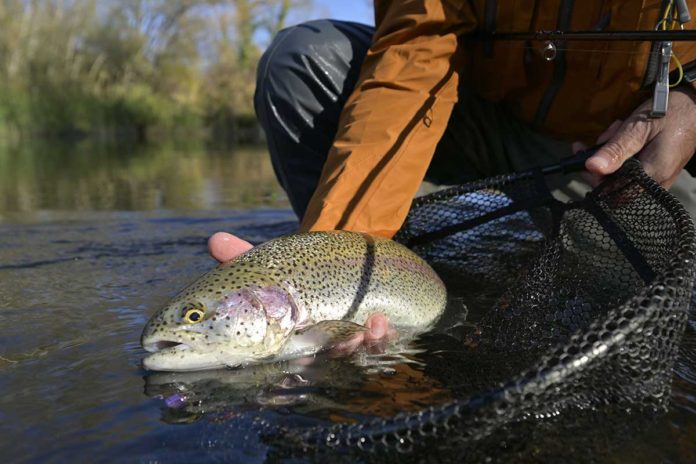Trout fishing in America can be some of the best in the world. Here are some great locations and a few great ways to fill your creel.
Maybe the best part about trout fishing in America is that if you search for the top 10 trout fishing locations, you’ll get 10 different lists with 10 different locations on each one. If you ask us, that’s a good thing.
From coast to coast whether you are fly fishing for rainbow trout, casting stickbaits for football shaped browns, or sitting patiently in a drift fishing boat on a river for wild steelhead, you’re experiencing some of the best angling in the U.S.
There are world class fisheries all over the nation and entire societies devoted to their preservation and upkeep to make sure that these pristine locations will always be there for future generations of trout fishing enthusiasts everywhere.
Finding the best of the opportunities is either an exercise in futility or a labor of love, but no matter which way you see it, the end result is one where your rod is bent and your hand ends up full of trout.
Instead of just listing all of the great trout fishing states, rivers, streams, or lakes, let’s look at the most popular species and go from there. Each type of trout comes from many different native locations, and some have thrived in the years since thanks to stocking efforts.
Rainbow Trout
As a matter of record, the rainbow trout has a squared, heavily spotted tail, a pink or reddish stripe down its side all the way to its cheek, and a white belly. This fish is one of the most abundant and heavily-stocked trout species in the United States due to its ability to survive very well in fish hatchery conditions.
Whether stocked or wild, rainbows can be found in virtually all 50 states in lakes, rivers, streams, and even ponds. There are two different variants of rainbows with two different names: the rainbow trout and the steelhead. Steelheads are anadromous which means that they spend much of their life in the ocean before migrating back to freshwater streams and rivers to spawn.
If you have a fish that never leaves freshwater, you’ve got a rainbow.
Have a hankering to catch some of the greatest fighting fish possible? Then head northwest into Oregon and Washington State for some of the most famous line-peeling runs and spectacular, acrobatic fights that you can imagine. If that kind of trip doesn’t fit into your plans, then maybe one of the five Great Lakes could fill the bill for you.
Spring spawning runs are the stuff of legend in the Great Lakes tributaries and even though these are stocked fish, they do so well during their life spans that it sometimes seems like they have been there forever.
As far as their cousins the rainbow trout are concerned, areas like the San Juan River, Yellowstone River, the Snake River, and Arkansas’s White River are just a few of the many places where fly fishermen do well to keep their arms from getting sore for all the fish they hook up with.
Brown Trout
Brown trout are considered to be native to Europe and western Asia, but they have long since found a home in the United States. The species was first introduced in the U.S. in 1884 as fingerlings in the state of Michigan from eggs reared and raised in then imported from Germany. Brown trout have been stocked in some 45 states in the U.S. with self sustaining populations now living in over 30 states.
The brown trout’s spotted appearance has a way of making it look like a water leopard with fins, and anyone who has battled with one will tell you that they fight much the same way. Brown trout will rise to a fly, gulp an inline spinner, or smash a stickbait, sometimes all on the same body of water.
Symbolic waters like the Yellowstone River, which is the longest un-dammed river system in the U.S., have thriving populations of browns. Also consider the Gunnison and Frying Pan Rivers in Colorado, and the Green River in Utah. And right when you think you’ve heard it all about fly fishing, head into the backwaters of Montana to the Gallatin River with a veteran outfitter and you’ll quickly realize that you’ve only just begun to learn what trout fishing in America is all about. It’s tough to determine the nation’s best without trying to name them all.
If you really want to have an adventure, try hiring one of the many great guide services around the Great Lakes, as trolling for big brown trout is their specialty. Browns on the Great Lake systems and in their tributaries are remarkable for their ability to crush every kind of lure, but stickbaits and spoons in the right colors will make them try to cut it in half.
Lake Trout
Cycles Schmidt ,7, of Cooperstown, caught this 32 inch lake trout through the ice on Otsego Lake while fishing with his…
Posted by Upstate NY Outdoors on NYup.com on Monday, February 8, 2021
The inimitable lake trout is native only to North America, from Alaska to Nova Scotia and throughout the Great Lakes, but they mainly exist in the northern areas of the continent. They prefer to live in colder, deeper lakes, usually 50 feet or more, and you can find them at depths well over 200 feet as well.
They are the largest of the trout species in the Great Lakes, sometimes growing to over 40 pounds and three feet in length, and are a top predator of baitfish like smelt. Adult lakers have a larger, more rounded head and a large mouth, a deeply forked tail, and light spots on a dark greenish to gray body.
For a monster lake trout experience, set your sights on areas such as the Flaming Gorge Reservoir on the Utah-Wyoming border. Lakers in the 50-pound range have been caught in this reservoir, some even with a fly rod, but most are caught by typical vertical jigging or trolling with down riggers.
All of the Great Lakes have good populations of lake trout, but maybe the biggest, Lake Superior, has some of the best lake trout fishing anywhere. Another great place to look for big lakers is in New York and Vermont’s Lake Champlain. Special fishing regulations permit the taking of lake trout all year in Lake Champlain, but back in the 1800s populations of the fish were almost wiped out.
Honestly some of the world’s best lake trout fishing, especially for big brutes, happens north of the border in Canada.
Brook Trout

According to the U.S. Fish & Wildlife Service, “Brook trout are native to eastern Canada and the northeastern United States. Their range extends as far west as Montana. The original range of the brook trout also includes the Appalachian Mountains, where they are still found in many high elevation streams as far south as Georgia.”
Brook trout live in the most clear, cool, and well oxygenated waters that you can imagine, including small to medium rivers and some lakes. This trout species is well known for being a litmus test for water quality; in other words, if the water is clean, these fish can live there. If not, they will die out.
It doesn’t get much better than brook trout fish for ardent fly fishing enthusiasts as they are some of the most wary fish you can target. Sure, they will also hit worms and natural bugs like grasshoppers, mayflies, and other terrestrial imitations, but brookies are well known for being as finicky as they are wary.
New York’s Adirondack Park is one of the Meccas for fly anglers with its pristine waters including high mountain ponds and lakes. Just about every small, cold stream in New England has wild populations of brook trout, where the only thing prettier than a fish rising to your fly is the look of your surroundings as it happens.
In the western half of Montana, brook trout are common throughout that part of the state in most major drainages. Although these fish are the remnants of stocked fish from the eastern U.S., brookies are still voracious feeders that have learned to spawn and thrive here.
The Main Takeaway
Honorable mention goes to the bull trout, cutthroat trout, and several other species and subspecies that just don’t get the same attention, but can still be found in the United States. Not only that, but states like Idaho, North Carolina, Missouri, Pennsylvania, New Hampshire and Connecticut all have terrific trout fisheries.
There are trout rivers across the nation that garner a lot of attention from Yellowstone National Park to the Missouri River that are surely worth planning a fishing trip of a lifetime. Whether you are looking for big trout, wild trout, or something in between, you’ll be hard pressed to find it anywhere else around the world in such a grand measure of trout water.
Fly fishers have entire societies based on wading spring creeks for large trout, and authors have written entire volumes on the subject.
Even if you are experienced as a trout fisherman, one thing that we could all learn from immensely is a well-rounded guide or charter captain. Skippers across the Great Lakes will put you on so many browns, rainbows, and lakers that your arm will be sore.

Looking for a little more or even hot lunch for your hunting blind? Follow my webpage, or on Facebook and YouTube.
NEXT: 6 WAYS TO CATCH A BROWN TROUT
Credit: Source link





























